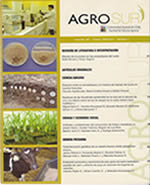Effect of date and sowing density on the development of pathogens existing in faba bean (Vicia faba L.) cultivars with determinate growth habit
Main Article Content
Abstract
Incorporation of new crop alternatives in an area requires to determine the agronomic factors that favour the crop and the potential limiting factors to achieve the potential yield. The objective of this study was to assess the presence and incidence of pathogens and yield according to seeding date, density and cultivar in determinate growth faba bean (Vicia faba L.) cultivars, which has been introduced in the Valdivia area. Presence and incidence of pathogen and yield were evaluated. Assays were conducted at the Santa Rosa Experimental Station and the Laboratory of Plant Pathology of the Universidad Austral de Chile, during two seasons (2009-2010 and 2010-2011). The pathogens found in the crops were Botrytis fabae, B. cinerea, Uromyces viciae fabae and Cercospora zonata.The incidence varied depending on seeding date, during the 2009/2010 season early seeding date (August 7) registered a reduced incidence of B. fabae (14.1%) and U. viciae fabae (0.4%) compared to a late seeding date (September 22) (B. fabae 84.3%; U. viciae fabae 75.2%), while in 2010/2011 season intermediate seeding date registered the lowest incidence of B. fabae (45.6%), with no statistically significant differences being observed for the others pathogens. Plant density and cultivar did not affect the pathogens. Early seeding dates (August 7 and September 1, 2010; September 1, 2011) and high plant density (30 and 40 plants m-2in the first season and 40 plants m-2 in the second season) had higher yields. Cultivars did not differ in yield. These results suggest that early sowing dates (August to early September) at high densities (40 plants m-2) should reduce the pathogen incidence and maximize yields of "baby" faba-bean in the Valdivia area.

